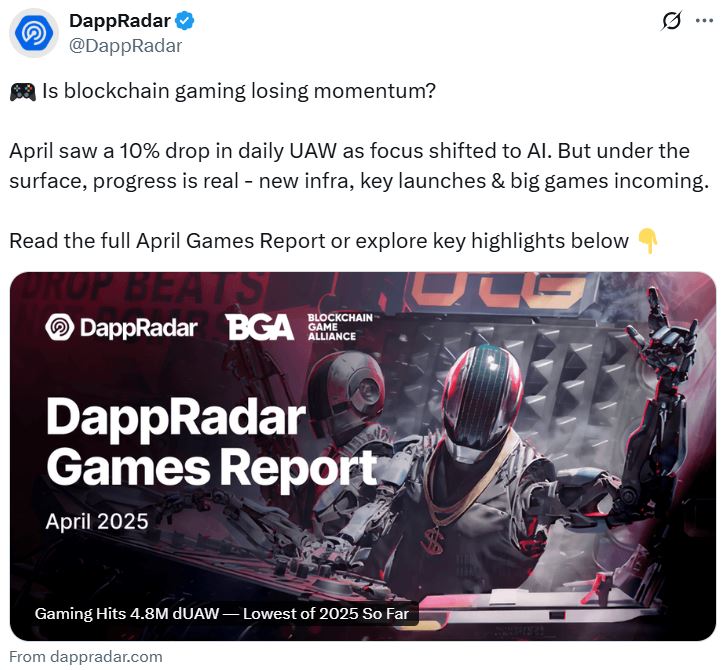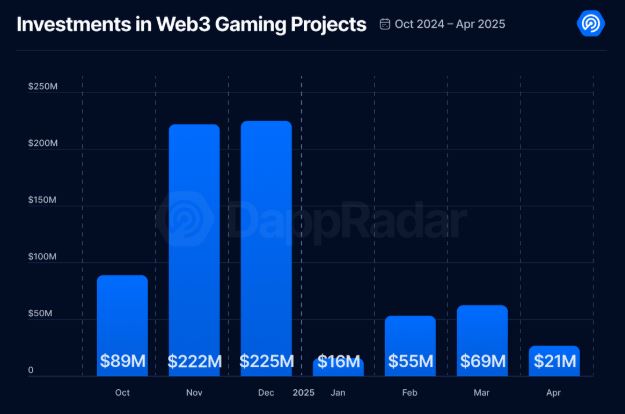While user activity in blockchain gaming experienced a dip in April 2025, dropping 10% to a low of 4.8 million Daily Unique Active Wallets (DUAW), the overall ecosystem is demonstrating signs of maturation and long-term health, according to a recent report by DappRadar. This decline in activity and funding does not necessarily signal a failing industry but rather a recalibration towards sustainability and genuine player engagement.
Key Takeaways from DappRadar’s April 2025 Games Report:
- User Activity Decline: Blockchain gaming user activity decreased by 10% in April, reaching 4.8 million DUAW.
- Investment Drop: Blockchain gaming investment activity fell by 69% from March, totaling $21 million.
- Ecosystem Maturation: Despite the downturn, the ecosystem is evolving, with increased infrastructure development and a focus on sustainable models.
- Shift in Focus: A move away from speculative play-to-earn mechanics towards genuine gameplay, asset ownership, and community engagement.
The report suggests a shift in user and investor attention towards areas such as real-world assets (RWAs) and artificial intelligence (AI), impacting investment in blockchain gaming. Furthermore, the macroeconomic landscape and ongoing market uncertainty contribute to a more cautious investor sentiment.
Sara Gherghelas, an analyst at DappRadar, notes that this period sees weaker projects falling by the wayside, with funding being redirected to projects focused on building a more robust and sustainable foundation for the next generation of blockchain games.

Infrastructure Development Takes Center Stage
An interesting highlight from the report is that a significant 66% of all blockchain game funding in 2025 has been allocated to infrastructure. This indicates a strategic focus on building the underlying framework necessary for the long-term success of the industry, rather than just focusing on individual game development.
This infrastructure investment includes:
- Scalability Solutions: Technologies that allow blockchain games to handle a large number of transactions and users without experiencing performance issues.
- Improved Development Tools: Resources that make it easier for developers to create high-quality blockchain games.
- Enhanced Security Measures: Protocols and systems designed to protect players and their assets from fraud and theft.
The Evolution of Blockchain Gaming
The blockchain gaming space is undergoing a significant evolution. The initial hype surrounding play-to-earn models, often fueled by speculation, is giving way to a more sustainable approach focused on delivering engaging gameplay experiences and fostering genuine community engagement.
This evolution is characterized by:
- A focus on quality: Developers are prioritizing the creation of compelling and enjoyable games, rather than simply relying on token incentives.
- Emphasis on asset ownership: Players are increasingly interested in owning and controlling their in-game assets, giving them a greater sense of agency and value.
- Building strong communities: Games are fostering communities where players can connect, collaborate, and share their experiences.
Mainstream Adoption and Future Outlook
The continued interest and experimentation from mainstream gaming companies are a positive sign for the future of blockchain gaming. Companies like Ubisoft and Sega are exploring the integration of blockchain technology into their games, signaling a growing acceptance and recognition of its potential.
Ubisoft’s partnership with Immutable, a leading Layer 2 scaling solution for NFTs on Ethereum, demonstrates a commitment to exploring blockchain gaming within established gaming ecosystems. Similarly, Sega’s inclusion of NFTs and play-to-earn mechanics in its game, KAI: Battle of Three Kingdoms, shows a willingness to experiment with new models of player engagement and monetization.

Challenges and Opportunities
While the future of blockchain gaming looks promising, there are still challenges to overcome. These include:
- Scalability: Blockchain networks need to be able to handle the high transaction volumes required by popular games.
- User Experience: Onboarding and using blockchain-based games needs to be more user-friendly for mainstream audiences.
- Regulation: Clear and consistent regulations are needed to provide clarity and certainty for developers and players.
Despite these challenges, the opportunities for blockchain gaming are vast. As the technology matures and adoption increases, blockchain games have the potential to revolutionize the gaming industry, offering players greater ownership, control, and value.
In conclusion, while April 2025 might not have been a record-breaking month for blockchain gaming, it represents a crucial period of recalibration and maturation. The focus on infrastructure development, sustainable models, and genuine player engagement suggests that the industry is moving in a positive direction. The builders are still building, the ecosystems are expanding, and the infrastructure is maturing, paving the way for a healthier and more sustainable future for blockchain gaming.